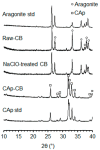Lamellar Septa-like Structured Carbonate Apatite Scaffolds with Layer-by-Layer Fracture Behavior for Bone Regeneration
- PMID: 38392158
- PMCID: PMC10886560
- DOI: 10.3390/biomimetics9020112
Lamellar Septa-like Structured Carbonate Apatite Scaffolds with Layer-by-Layer Fracture Behavior for Bone Regeneration
Abstract
Generally, ceramics are brittle, and porosity is inversely correlated with strength, which is one of the challenges of ceramic scaffolds. Here, we demonstrate that lamellar septum-like carbonate apatite scaffolds have the potential to overcome these challenges. They were fabricated by exploiting the cellular structure of the cuttlebone, removing the organic components from the cuttlebone, and performing hydrothermal treatment. Scanning electron microscopy revealed that the scaffolds had a cellular structure with walls between lamellar septa. The interwall and interseptal sizes were 80-180 and 300-500 μm, respectively. The size of the region enclosed by the walls and septa coincided with the macropore size detected by mercury intrusion porosimetry. Although the scaffold porosity was extremely high (93.2%), the scaffold could be handled without disintegration. The compressive stress-strain curve demonstrated that the scaffolds showed layer-by-layer fracture behavior, which seemed beneficial for avoiding catastrophic failure under impact. When the scaffolds were implanted into rabbit femurs, new bone and blood vessels formed within the scaffold cells at 4 weeks. At 12 weeks, the scaffolds were almost entirely replaced with new bone. Thus, the lamellar septum-like cellular-structured carbonate apatite is a promising scaffold for achieving early bone regeneration and compression resistance.
Keywords: bioinspired materials; biomimetics; cuttlebone; scaffold; tissue engineering.
Conflict of interest statement
The authors declare no conflicts of interest.
Figures










References
Grants and funding
LinkOut - more resources
Full Text Sources

